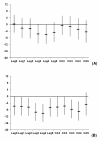Apparent temperature and acute myocardial infarction hospital admissions in Copenhagen, Denmark: a case-crossover study
- PMID: 22463704
- PMCID: PMC3353865
- DOI: 10.1186/1476-069X-11-19
Apparent temperature and acute myocardial infarction hospital admissions in Copenhagen, Denmark: a case-crossover study
Abstract
Background: The influence of temperature on acute myocardial infarction (AMI) has not been investigated as extensively as the effects of broader outcomes of morbidity and mortality. Sixteen studies reported inconsistent results and two considered confounding by air pollution. We addressed some of the methodological limitations of the previous studies in this study.
Methods: This is the first study of the association between the daily 3-hour maximum apparent temperature (Tapp(max)) and AMI hospital admissions in Copenhagen. The study period covered 1 January 1999-31 December 2006, stratified in warm (April-September) and cold (October-March) periods. A case-crossover epidemiology study design was applied. Models were adjusted for public holidays and influenza, confounding by PM₁₀, NO₂ and CO was investigated, the lag and non-linear effects of Tapp(max) was examined, effect modification by age, sex and SES was explored, and the results of the case-crossover models were compared to those of the generalised additive Poisson time-series and generalised estimating equation models.
Results: 14,456 AMI hospital admissions (12,995 people) occurred during the study period. For an inter-quartile range (6 or 7°C) increase in the 5-day cumulative average of Tapp(max), a 4% (95% CI:-2%; 10%) and 9% (95% CI: 3%; 14%) decrease in the AMI admission rate was observed in the warm and cold periods, respectively. The 19-65 year old group, men and highest SES group seemed to be more susceptible in the cold period.
Conclusion: An increase in Tapp(max) is associated with a decrease in AMI admissions during the colder months.
Figures




References
-
- World Health Organisation. Air Quality Guideline Global Update. 2005. http://www.who.int/phe/health_topics/outdoorair_aqg/en/. Last accessed: 19 March 2012.
Publication types
MeSH terms
LinkOut - more resources
Full Text Sources
Medical
Molecular Biology Databases
Miscellaneous

